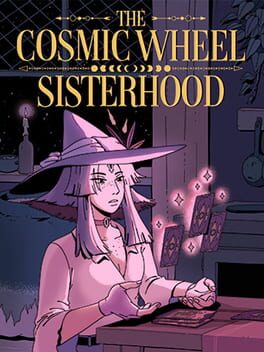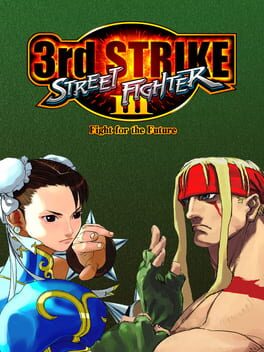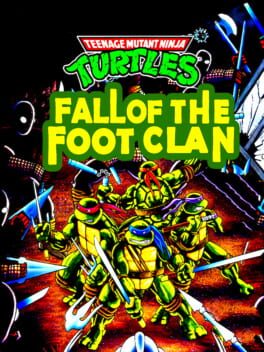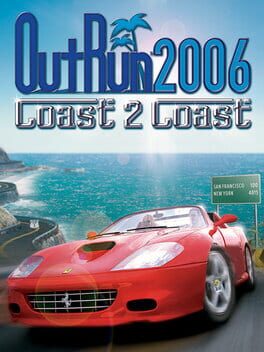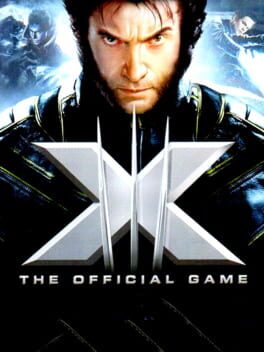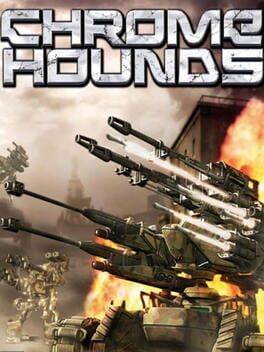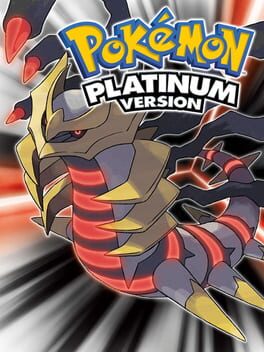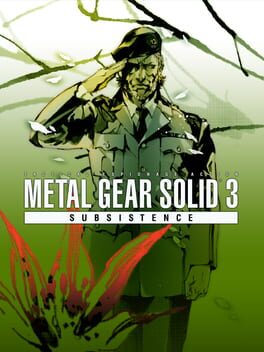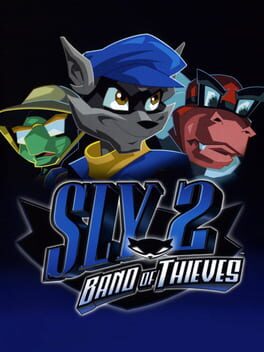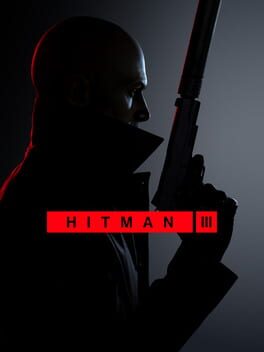EdgarAllanBro
35 reviews liked by EdgarAllanBro
Note: I got a review copy of this game
Very likely to be my Game of the Year for 2023. A touching story of self-discovery, sacrifice, and the dark places our minds go when we are alone.
But it's also a tale of starting over, forgiving ourselves, and forging a new way forward for ourselves.
It's about the lies we tell ourselves, our naive beliefs, our jaded natures, and the people we meet, love, and betray on our paths through this life.
It hooked me nearly from the jump and I think it's telling that, on the day Mario Wonder and Spider-Man 2 came out, it was The Cosmic Wheel Sisterhood that I stayed up until 3am playing.
Truly special. Please play it. Thank you developers.
Very likely to be my Game of the Year for 2023. A touching story of self-discovery, sacrifice, and the dark places our minds go when we are alone.
But it's also a tale of starting over, forgiving ourselves, and forging a new way forward for ourselves.
It's about the lies we tell ourselves, our naive beliefs, our jaded natures, and the people we meet, love, and betray on our paths through this life.
It hooked me nearly from the jump and I think it's telling that, on the day Mario Wonder and Spider-Man 2 came out, it was The Cosmic Wheel Sisterhood that I stayed up until 3am playing.
Truly special. Please play it. Thank you developers.
Baldur's Gate 3
2023
Expressiveness is the quality that defines roleplaying games: they’re judged by how freely players can assert themselves in a reactive space. Players want to convey their personality and make choices, but while these are the obvious core concepts of the genre, Baldur’s Gate 3 has proven to me that they’re not what makes an RPG great. Having the capacity to make decisions is certainly a necessity, but decisions only matter when players care about the outcomes. Choices surround us in every moment of our lives, but most vanish from our minds within seconds for that very reason; they’re so emotionally inconsequential as to be hardly worthy of notice. So, more fundamental than allowing for choice is providing a real adventure in which to make those choices, and defining a journey which has players encountering challenges, learning, changing, and overcoming. This is the critical component which Baldur’s Gate fails to establish, most glaringly from its narrative structure.
(Minor spoilers through act 2)
In the opening cutscene, your character has a mindflayer tadpole inserted into their head, so your call to adventure is getting it out. This is fine in itself, but the game is quick to tell you that there’s no urgency to this task, relieving you of the burden of care. Every quest you receive to accomplish this goal, across the first ~22 hours of gameplay, results in failure where your party just sorta gives up. It takes another ten hours before the main villains are established, a stale group of evil zealots of evil gods who just love being evil, pursuing an agenda which players can't feel meaningfully aligned against. The simplicity of the central narrative gives the impression it’s just supposed to be a foundation for a character-driven story, but the interpersonal aspect is similarly lacking. In what feels like a symptom of the game's long stay in early-access, your companions put their love and trust in you in act 1, before anyone’s had the chance to organically develop relationships or encounter life-changing struggles. Characters don’t have the time and space to have an arc, and you don’t get the chance to express yourself alongside them, you simply skip to the end for an immediate and vacuous payoff. There’s no journey here, you’re simply being presented with scenes from an adventure without actually going on one.
The same can be said for the mechanics, even when they’re lifted from the tabletop game, thanks to a design philosophy where every playstyle is thoroughly accommodated. This seems like a good strategy in a genre where players want to assert themselves, but the refusal to challenge players leaves unique approaches feeling irrelevant. Even with a party led by a Githyanki barbarian, with very little in the way of charisma, intelligence, or skill, there was never a time I couldn’t overcome a situation in an optimal way. I could pick whatever locks I wanted, disarm whatever traps I wanted, circumvent any barrier I wanted; the game never asked me to think ahead or prepare. I didn’t have to be ready with certain spells or proficiencies, it never demanded more than following a clear path. Even if it did, the cheap respecs mean that you’re a maximum of 400 gold away from having a team perfectly suited to the task at hand, and even if you don’t end up using that option, knowing that your choices are so impermanent is a detriment to any feeling of growth.
That’s the key here: growth. My characters leveled up, but I don't feel like they grew. I traveled, but I don’t feel like I went on a journey. I made choices, but I don’t feel like I went in new directions. After a fifty-hour playthrough, all I remember was that I chilled out, ran around some nice maps, and managed my inventory. I spent all that time relaxing well enough, but I didn’t overcome challenge, feel much, or learn anything. All I could confidently state that the game did for me is live up to its basic selling point, of being an adventure I could take at home, a journey where I go nowhere.
(Minor spoilers through act 2)
In the opening cutscene, your character has a mindflayer tadpole inserted into their head, so your call to adventure is getting it out. This is fine in itself, but the game is quick to tell you that there’s no urgency to this task, relieving you of the burden of care. Every quest you receive to accomplish this goal, across the first ~22 hours of gameplay, results in failure where your party just sorta gives up. It takes another ten hours before the main villains are established, a stale group of evil zealots of evil gods who just love being evil, pursuing an agenda which players can't feel meaningfully aligned against. The simplicity of the central narrative gives the impression it’s just supposed to be a foundation for a character-driven story, but the interpersonal aspect is similarly lacking. In what feels like a symptom of the game's long stay in early-access, your companions put their love and trust in you in act 1, before anyone’s had the chance to organically develop relationships or encounter life-changing struggles. Characters don’t have the time and space to have an arc, and you don’t get the chance to express yourself alongside them, you simply skip to the end for an immediate and vacuous payoff. There’s no journey here, you’re simply being presented with scenes from an adventure without actually going on one.
The same can be said for the mechanics, even when they’re lifted from the tabletop game, thanks to a design philosophy where every playstyle is thoroughly accommodated. This seems like a good strategy in a genre where players want to assert themselves, but the refusal to challenge players leaves unique approaches feeling irrelevant. Even with a party led by a Githyanki barbarian, with very little in the way of charisma, intelligence, or skill, there was never a time I couldn’t overcome a situation in an optimal way. I could pick whatever locks I wanted, disarm whatever traps I wanted, circumvent any barrier I wanted; the game never asked me to think ahead or prepare. I didn’t have to be ready with certain spells or proficiencies, it never demanded more than following a clear path. Even if it did, the cheap respecs mean that you’re a maximum of 400 gold away from having a team perfectly suited to the task at hand, and even if you don’t end up using that option, knowing that your choices are so impermanent is a detriment to any feeling of growth.
That’s the key here: growth. My characters leveled up, but I don't feel like they grew. I traveled, but I don’t feel like I went on a journey. I made choices, but I don’t feel like I went in new directions. After a fifty-hour playthrough, all I remember was that I chilled out, ran around some nice maps, and managed my inventory. I spent all that time relaxing well enough, but I didn’t overcome challenge, feel much, or learn anything. All I could confidently state that the game did for me is live up to its basic selling point, of being an adventure I could take at home, a journey where I go nowhere.
If I had to describe 3rd strike in one word that would be "freedom". The game gives players a plethora of options in any situation. This is by design and has been discussed by Shinichiro Obata [1]: the game is built around "unanswerables" - the idea of creating situations with no clear answers/solutions/resolutions. This is done in order to avoid gameplay based around preset knowledge of situations, and instead emphasizes RPS mechanics more than other games in the genre. But how is this achieved in the game and what are its consequences?
The key to achieving such freedom is the heavy reliance on universal mechanics. The parry is an obvious example of this, along with mechanics such as the throw protection after blockstun/wakeup, crouch teching (also the extra damage done to crouching opponents). With the existence of those few mechanics, the player has plenty of tools at their disposal, that are universal across characters. There are no situations where the pool of answers is severely limited. Additionally, while some options cover a broader range of actions, the game always has a way to reward guessing the exact action that the other player will take. Because of this, every single decision carries risk and nothing is truly safe. Blocking is still the "safest" option, but it can be opened up by overheads into confirms and command grabs for reasonable damage. If that is not in a character's toolkit, then the simple throw loop in the corner can force out a reaction other than blocking. All of this contributes to creating an extremely unpredictable playstyle. Habits and predictable play can be punished severely, resulting in a game that promotes more attentive play and non-rigid playstyles.
Let's take a look at a practical situation in which those tools come into play. Dudley is a character with a strong 50/50 of an overhead or a low hit confirms that could lead to yet another 50/50 each time it is successful. If it is blocked correctly it leads back to neutral. In most other fighting games, without considering reversals (which still exist in 3S), this would be a situation where Dudley can use his absurd okizeme to play in a highly beneficial position. However, since this is 3S the opponent can always go for the parry instead. If successful it would give the defender a very strong combo in retaliation and more pressure afterwards as well. This turns the 50/50 into a double-edged sword. Yet while parrying is strong it still has its own counters - throws, delayed meaties, normals into cancels. In turn these have their own counters. The key takeaway is that, starting from 2 options (and potentially a throw sometimes), that would be the most efficient in most other fighting games, we get to create a variety of new options both sides have to consider and can use viably.
It is important to mention that those tools also limit the theoretical knowledge needed to play the game. While there is knowledge that could benefit a player, any situation provides enough information by itself for its resolution (answer). While frame data has its usage, it takes a backseat to elements like the pushback and ways in which an attack can be parried (low/high or both). Both of those elements can be deduced from the visuals alone. Even if it is a player's turn/a player has priority/advantage, the threat of a parry can steal that turn. This can be used both to escape pressure situations from frame traps or to even further your own pressure - the parry is a tool that can be used both defensively and offensively. Character specific tools still have their play, but rather than limiting or completely substituting your universal options, they tend to instead give you completely new options and create new situations.
All of it leads to some of the most unpredictable matches that one can find in the genre, while also being reasonably easy to play. It does require knowledge of those universal mechanics, but while more specific knowledge is helpful, it is often not required.
[1] If you want to read it for yourself I recommend the SF3 an oral history feature from polygon, the topic in question is discussed in the final bit of the interview.
The key to achieving such freedom is the heavy reliance on universal mechanics. The parry is an obvious example of this, along with mechanics such as the throw protection after blockstun/wakeup, crouch teching (also the extra damage done to crouching opponents). With the existence of those few mechanics, the player has plenty of tools at their disposal, that are universal across characters. There are no situations where the pool of answers is severely limited. Additionally, while some options cover a broader range of actions, the game always has a way to reward guessing the exact action that the other player will take. Because of this, every single decision carries risk and nothing is truly safe. Blocking is still the "safest" option, but it can be opened up by overheads into confirms and command grabs for reasonable damage. If that is not in a character's toolkit, then the simple throw loop in the corner can force out a reaction other than blocking. All of this contributes to creating an extremely unpredictable playstyle. Habits and predictable play can be punished severely, resulting in a game that promotes more attentive play and non-rigid playstyles.
Let's take a look at a practical situation in which those tools come into play. Dudley is a character with a strong 50/50 of an overhead or a low hit confirms that could lead to yet another 50/50 each time it is successful. If it is blocked correctly it leads back to neutral. In most other fighting games, without considering reversals (which still exist in 3S), this would be a situation where Dudley can use his absurd okizeme to play in a highly beneficial position. However, since this is 3S the opponent can always go for the parry instead. If successful it would give the defender a very strong combo in retaliation and more pressure afterwards as well. This turns the 50/50 into a double-edged sword. Yet while parrying is strong it still has its own counters - throws, delayed meaties, normals into cancels. In turn these have their own counters. The key takeaway is that, starting from 2 options (and potentially a throw sometimes), that would be the most efficient in most other fighting games, we get to create a variety of new options both sides have to consider and can use viably.
It is important to mention that those tools also limit the theoretical knowledge needed to play the game. While there is knowledge that could benefit a player, any situation provides enough information by itself for its resolution (answer). While frame data has its usage, it takes a backseat to elements like the pushback and ways in which an attack can be parried (low/high or both). Both of those elements can be deduced from the visuals alone. Even if it is a player's turn/a player has priority/advantage, the threat of a parry can steal that turn. This can be used both to escape pressure situations from frame traps or to even further your own pressure - the parry is a tool that can be used both defensively and offensively. Character specific tools still have their play, but rather than limiting or completely substituting your universal options, they tend to instead give you completely new options and create new situations.
All of it leads to some of the most unpredictable matches that one can find in the genre, while also being reasonably easy to play. It does require knowledge of those universal mechanics, but while more specific knowledge is helpful, it is often not required.
[1] If you want to read it for yourself I recommend the SF3 an oral history feature from polygon, the topic in question is discussed in the final bit of the interview.
Final Fantasy XVI
2023
Wife’s Reaction:
“I’m so happy you’re so happy; otherwise life would be crappy.”
The Legacy of the Crystals:
I adore Final Fantasy thanks to the series’ tradition of premium presentation, breathtaking music, and a unique identity for each entry. FFXVI had all that plus an awesome cast, insanely tight combat, and the most epic moments I’ve played in a game bookended by plenty of quiet and emotional beats. It’s a dream game that exceeded my hype.
“I’m so happy you’re so happy; otherwise life would be crappy.”
The Legacy of the Crystals:
I adore Final Fantasy thanks to the series’ tradition of premium presentation, breathtaking music, and a unique identity for each entry. FFXVI had all that plus an awesome cast, insanely tight combat, and the most epic moments I’ve played in a game bookended by plenty of quiet and emotional beats. It’s a dream game that exceeded my hype.
Wife’s Reaction:
“It looks like Dead Space but without all the, ya know, makes monster noises.”
Ready for Prime Time:
I forgot a lot about Prime in the nearly 20 years since I played it. It’s an achievement of a video game. I’ve focused a lot on Castlevania games in the last two years, searching for the next game that captures what I love about the series. Prime is as aces of a translation of the formula into 3D as there can be.
“It looks like Dead Space but without all the, ya know, makes monster noises.”
Ready for Prime Time:
I forgot a lot about Prime in the nearly 20 years since I played it. It’s an achievement of a video game. I’ve focused a lot on Castlevania games in the last two years, searching for the next game that captures what I love about the series. Prime is as aces of a translation of the formula into 3D as there can be.
Alex's Cowabunga Collection Marathon, Pt. 2 of 13
Playing this back-to-back with the first NES TMNT game was surprisingly jarring! That was hard, this is easy. That had sprawling and confusing areas, these are as simple as can be. No rewinding required on this one. Some quick notes:
- I really gotta read the digital manuals before playing the rest of these, I didn't realize you could throw shurikens (by attacking while crouched) or that jump attacks did double damage until halfway through the last level.
- Very samey. Walk to the right, attack the same 5 or 6 enemies, then the Technodrome has spikes. That's about it!
- "Vaporized into Milk Shake"???
- Krang's little post-credits smile was legitimately the best part of the game.
Playing this back-to-back with the first NES TMNT game was surprisingly jarring! That was hard, this is easy. That had sprawling and confusing areas, these are as simple as can be. No rewinding required on this one. Some quick notes:
- I really gotta read the digital manuals before playing the rest of these, I didn't realize you could throw shurikens (by attacking while crouched) or that jump attacks did double damage until halfway through the last level.
- Very samey. Walk to the right, attack the same 5 or 6 enemies, then the Technodrome has spikes. That's about it!
- "Vaporized into Milk Shake"???
- Krang's little post-credits smile was legitimately the best part of the game.
Chromehounds
2006
Chromehounds
2006
Would be rated higher if there was any singleplayer or local content worth a damn. However, back in the day this game had some of the greatest online multiplayer I've ever experienced. The mech building mechanic was highly detailed and customizable without being overwhelming. If only there was anything close to this experience nowadays.
